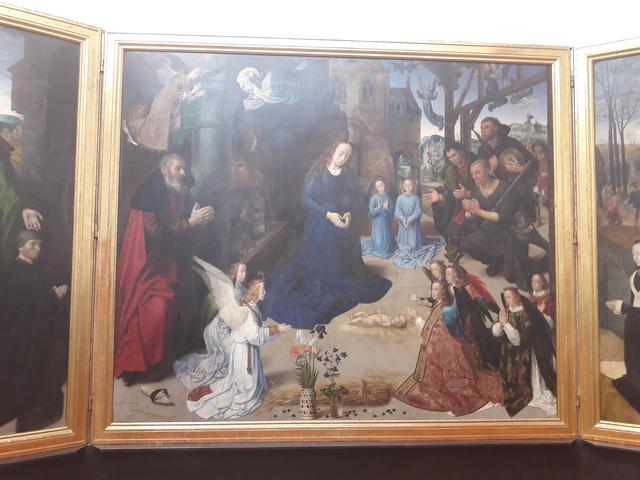Portinari triptych

The baby Jesus lies on the ground surrounded by rays of light to represent him as the Light of the world. His mother Mary, father Joseph, several angels and the shepherds surround him in adoration. In the background, the previous moment in the narrative sequence, when the angel announces the birth of the Savior, is represented in the surrounding landscape. The continuity of the background landscape blurs the division between the central image and the side panels, where the family who commissioned the work is shown in prayer under the protection of four saints. On the left, the apostle Thomas and Saint Anthony the Great preside over the head of the family Tommaso Portinari and his two sons Antonio and Pigello, while on the right, Saint Margaret, victorious over the dragon that had swallowed her, and Mary Magdalene, With a bottle of ointment, keep an eye on Maria Baroncelli Portinari and her daughter Margherita. The different proportions of saints and family members reflect their position in the social and religious hierarchy.
Originally from Florence, Tommaso Portinari (1428-1501) lived in Bruges for many years, where he worked as a representative of the Medici family bank. In 1470 he married Maria Baroncelli, also from Florence; The family is represented with clothes and hairstyles that reflect the flamenco fashion of the time. While in Flanders, Tommaso Portinari commissioned the Flemish painter Hugo van der Goes to paint the Triptych of the Adoration of the Shepherds to adorn the Portinari family chapel in the church of Saint Giles in the Santa Maria Nuova hospital in Florence. The arrival of the painting in Florence in 1483, after reaching Pisa by sea, was quite an event; The work was perceived as extraordinarily innovative in the eyes of Florentine painters, who particularly praised the realistic resemblance of objects, landscape, and facial features. The still life images in the central foreground are striking and abound in symbolic references: the white iris and the red lily allude to the theme of purity and the blood of Jesus shed during the Passion of Christ, the purple columbine represents pain of the Virgin Mary. , while carnations symbolize the Holy Trinity.
When closed, the triptych showed a representation of the Annunciation, painted in black and white on the back of the doors.
© Tourblink